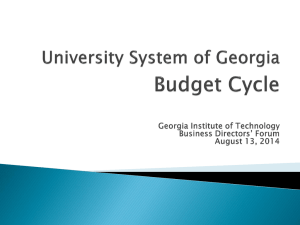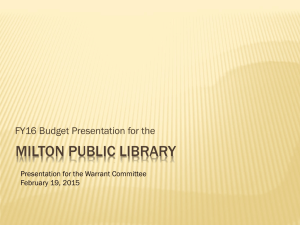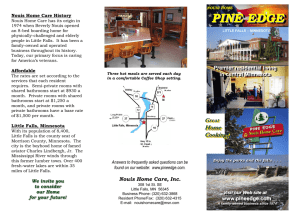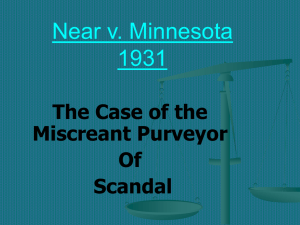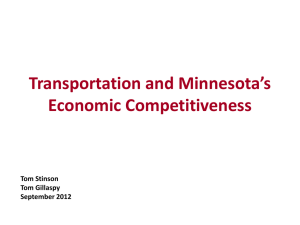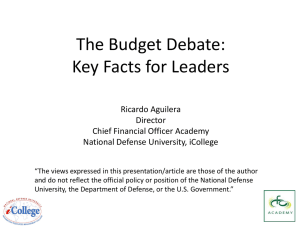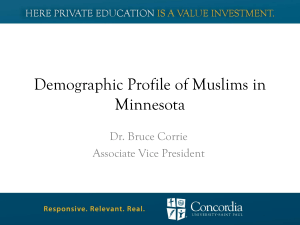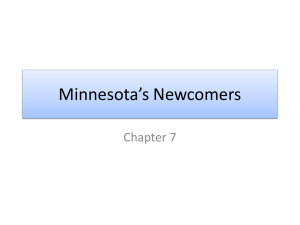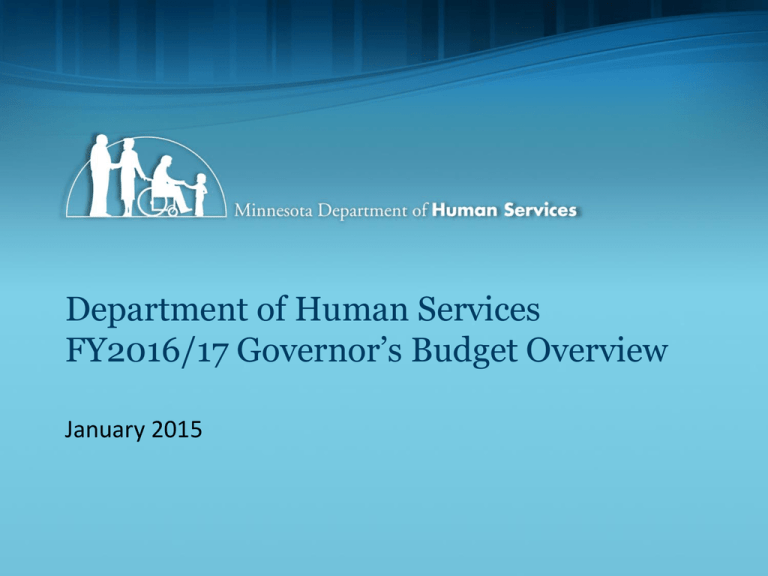
Department of Human Services
FY2016/17 Governor’s Budget Overview
January 2015
2014 – 2015 direct appropriations for DHS
We spend 77% on basic & long-term health care
Economic
support and
other grants,
11.8%
MSOP, 1.3%
Technical
activities (TANF),
1.3%
Central office,
2.8%
Mental &
chemical health,
5.8%
77%
Long-term
health care,
28.8%
Basic health
care, 48.4%
Source: Minnesota Management & Budget BPAS data
2
What creates health?
Physical
environment
10%
Clinical care
10%
Health behaviors
30%
Social and
economic factors
40%
Source: Minnesota Department of Health
Genes and biology
10%
3
We have invested in health care
expansion to cover more Minnesotans
Percent of uninsured in Minnesota
9.0%
9.0%
8.2%
7.7%
7.2%
6.1%
4.9%
2001
2004
2007
2009
2011
2013
2014
Source: 2013 Minnesota Health Access Survey, Minnesota Department of Health and University of
Minnesota, School of Public Health’s State Health Access Data Assistance Center
4
Now, we are turning our attention to
the other factors that create health
We need to make new investments in areas of our
budget where it makes the biggest difference.
• Children and Families
• Mental Health
This will help address the challenges we face.
5
Challenges: Mental health capacity
6
Challenges: Gaps in substance use
treatment
• 1 in 18 Minnesotans with substance disorders
receive treatment
Source: 2010 Minnesota Survey on Adult Substance Use
7
Challenges: Access to care
Percentage of Medicaid children receiving preventive dental
services
60%
Minnesota
United States
50%
40%
30%
20%
10%
0%
2010
2011
2012
8
Challenges: Increased child poverty
• 78,000 children in Minnesota are in deep poverty
– living at half or less of the poverty line
9
Challenge: Children and housing
Current issues: The number of homeless children and
their families has almost quadrupled per one-night
shelter counts
9,654
7,696
7,854
10,214
Total count
7,751
5,645
4,553
3,079
3,178
1,791
2,294
2,862
2,726
1994
3,546
Children with parents
889
1991
3,251
1997
2000
2003
2006
2009
2012
10
Challenges: Age wave
Minnesotans over age 65
1,299,460
25
1,200,000
20
15
947,520
1,000,000
800,000
677,270
20.6
10
5
1,400,000
12.9
15.9
600,000
400,000
200,000
0
0
2010
2020
Percent of population
2030
Minnesotans over age 65
11
Challenges: Pressure on the system
Number of elderly served in Medicaid
120,000
98,661
100,000
85,326
80,000
66,695
60,000
40,000
49,172
40,024
20,000
0
2010
2020
2030
2040
2050
12
Our budget priorities start to
address these challenges
• Children and
Families
• Mental Health
• Direct Care and
Treatment
• Infrastructure
and
Requirements
• Health Care
• Continuing Care
13
CHILDREN AND FAMILIES
• Problem: 78,000 children in Minnesota are in
deep poverty – living at half or less of the poverty
line
What investments have we made?
Visits to 4-star Parent Aware child care centers
Top: Y Early Learning in St. Paul
Bottom: Panda’s Playhouse in Sartell
• Created Northstar Care for
Children
• Expanded support for
parents
• Improved child care quality
through Parent Aware
• Increased funding for sex
trafficked and homeless
youth
• Established Housing
Assistance grant for some
MFIP families
15
Challenges that still exist
In Minnesota:
• 5 in 10 Black children
• 4 in 10 American Indian children
• 3 in 10 Hispanic children
• 2 in 10 Asian children and
• 1 in 10 White children …
LIVED IN POVERTY IN 2012
Source: U.S Census Bureau, 2012 American Community Survey
16
Children and Families: Our 2015
proposals
• Invest in Quality Child Care
• Simplify child care assistance requirements to reduce complexity for
participants and counties ($1.6M in FY16/17)
• Revise Basic Sliding Fee child care allocation formula and reduce the waitlist currently at 6,939 ($12.5M in FY16/17)
• Sustain the Parent Aware Quality Rating System
($3.5M in FY16/17)
• Address disparities and work with our tribal partners
• Support expanded tribal administration of human services programs for WEN
($2.8M in FY16/17) and Red Lake TANF ($284K in FY16/17)
• Establish an American Indian Family Early Intervention Program to families
who are at risk for possible child maltreatment ($2M in FY16/17)
• Change how funds will be allocated and distributed to tribes related to the
Tribal Customary Adoption Grants (Budget Neutral)
• Invest in targeted, coordinated, culturally-specific care for pregnant mothers
at high risk of poor birth outcomes from drug use ($272K in FY16/17)
17
Children and Families: Our 2015
proposals continued
• Oral Health ($9.9M in FY16/17)
• Reform the way Oral Health services are provided in Medical Assistance and
MinnesotaCare.
• Child protection ($2.5M in FY16/17)
• Support best practices
• Increase accountability for county and tribal child welfare agencies
• Support Families in Minnesota
• Eliminate the application fee for Child Support Services ($34K in FY16/17)
• Make necessary changes to Northstar Care for Children (Budget Neutral)
• Increase funding for food support in the Minnesota Food Assistance Program
(MFAP) ($1.1M in FY16/17)
18
COMMUNITY SUPPORTS
ADMINISTRATION
• Problem: The mental health infrastructure is
insufficient with too many gaps, structurally and
financially fragile, limited service availability, and
inconsistent measurement
What investments have we made?
• School-linked mental
health
• Crisis response for
children and adults
• Increased some
payment rates
• Established new
benefits
School-linked mental health grant announcement,
Edison High School, Minneapolis
20
Challenges that still exist
• Existing community capacity does not meet needs - Anoka Metro Regional
Treatment Center has a waiting list of 77
• Some children’s services are not available in Minnesota - We have between 300400 children each year who would be best served in Psychiatric Residential
Treatment Facilities
• Rates are often insufficient to cover the cost of services - Riverwood Centers, which
served some 3,000 clients, closed suddenly in 2014
• Lack of treatment services for the most acute children and adults - The system does
not have adequate resources for the most aggressive clients
• We have work force issues - Most of Minnesota is designated as a Mental Health
Professional Shortage Area
• Focus has been on treatment and interventions, leaving prevention and early
interventions behind
21
Why is mental health a top priority for 2015?
Nearly 30 years after passage of the state’s Comprehensive Mental Health Act, the
vision of a state-wide system of adult mental health services is far from complete.
Adult Mental Health Provider Availability
Ratings Based on Provider Location
Current as of 3-26-14
Adult Mental Health Initiative Areas
Adult Mental Health Service
Statewide
Capacity
Anoka
BCOW
Carver
Scott
CommUNITY
CREST
Dakota Hennepin
NW 8
RamseyRegion 2 Region 3
Washington
Region 4
South
Region 5+ Region 7E
South
Central 10
SW 18
Inpatient Psychiatric Hospitalization
Intensive Residential Treatment (IRTS)
Mobile Crisis
Assertive Community Treatment (ACT)
Permanent Supportive Housing
Partial Hospitalization
Residential Crisis Services
Adult Rehabilitative MH Services (ARMHS)
Case Management- MHTCM
Medication Management
Service Meets Demand
Limited Service Availability
Red = No provider is located in this area.
22
Why is mental health a top priority for 2015?
25 years after passage of the state’s Comprehensive Mental Health Act, the vision
of a state-wide system of children’s mental health services is even less developed.
Children's Mental Health Provider Availability
Children's Mental Health Service
Statewide
Capacity
1
2
Ratings Based on Provider Location
Children's Mental Health Region Areas
3
4
5
6E
6W
7E
7W
Current as of 032714
8
9
10
11
Inpatient Hospitalization
Psychiatric Residential Treatment Fac. PRTF
Children’s Residential Treatment CRT
Treatment Foster Care
Partial Hospitalization
Youth ACT
Day Treatment
Crisis Services
Case Management
Family Peer Specialist
Children’s Therapeutic Serv&Supports CTSS
School-Linked
Early Childhood MH
Outpatient Treatment
Psychiatry
Diagnostic Assessment (0-5)
Diagnostic Assessment (6-21)
Integrated PCP
Service Meets Demand
Limited Service Availability
Red = No provider is located in this area.
23
We need to expand services in the
continuum of care
Early
intervention
What needs to be done
What’s been done
Prevention
•
•
•
•
ACES
Trauma-informed
Multigenerational
Primary care access
•
•
•
•
•
•
•
•
Implement Behavioral
Health Homes
Mental health
consultation
School-based diversion
First episode psychosis
intervention
•
•
•
•
Treatment
Screening
Appropriate
assessments
School-linked mental
health
Crisis response
•
•
Expand Crisis services
Certify Behavioral
Health Clinics
Reduce ACEs
Expand Respite Care
• Create Psychiatric
Residential Treatment
facilities; Close CABHS
• Stabilize and reform MH
payment structures
• Psychiatric Residency
Program
• Increase capacity for
people with complex
needs
• MSH funding
•
Benefits in MHCPs
Evidence-based
practices
Standardized measures
Recovery
• Peer specialists
• Housing programs to
reduce homelessness
• Respite grants
• Supported employment
• Expand supported
housing
• ACT quality and
expansion
• Flexibility in our
Transitions Initiatives
24
Mental Health: Our 2015 proposals
• Prevention
• Incorporate primary care and support for wellness in Behavioral
Health Homes ($6.9M in FY16/17)
• Mental health consultation for early childhood providers ($922K in
FY16/17)
• School-based diversion pilot for students with co-occurring disorders
($65K in FY16/17)
• Intervene in first episode psychosis ($260K in FY16/17)
• Early Intervention
• Expansion of crisis services ($4.7M in FY16/17) and respite care
($847K in FY16/17) to keep people in the community and out of
hospitals
• Certify Behavioral Health Clinics ($398K in FY16/17)
• Reduce the incidence of Adverse Childhood Experiences (ACEs)
($796K in FY18/19)
25
Mental Health: Our 2015 proposals
• Treatment
• Begin to establish Psychiatric Residential Treatment capacity in the state
($6.6M in FY16/17) and close Child and Adolescent Behavioral Health
Services (CABHS) ($1.3 M investment in FY16/17; savings thereafter)
• Stabilize and reform mental health services payment structure ($5.5M in
FY16/17)
• Create Public Psychiatric Residency Program ($354K in FY16/17)
• Increase residential services within DCT for individuals with complex
conditions ($4.8M in FY16/17)
• Minnesota Security Hospital ongoing funding to continue improvements
needed from conditional licensure ($11.2M in FY16/17)
• Recovery
• Increase access to housing with supports for adults with mental illness
($4.7M in FY16/17)
• Improve and expand the Assertive Community Treatment (ACT) program
($1.3M in FY16/17)
• Create more flexibility for our Transitions Initiative (Budget Neutral)
• Create initial licensure standards for withdrawal management
(Budget Neutral)
26
Housing and Olmstead: Our 2015
proposals
• Invest in a new way to provide housing in Minnesota for people
with disabilities – Olmstead Goal ($3.1M in FY16/17)
• Data collection support for Plan to Prevent and End Homelessness
($1.2M in FY16/17)
Additional proposals in the spirit of Olmstead:
•
•
•
•
•
•
•
Expansion of Mental Health Crisis Services
Quality improvement and expansion of Assertive Community Treatment
Housing with Supports - expands housing options for Adults w/ MI
Jensen Settlement Administrative Costs - improves access to community based
living options
Psychiatric Residential Treatment Facility
Increased Capacity for Individuals with Complex Conditions
Transitions Initiative Flexibility
27
DIRECT CARE AND
TREATMENT
• Problem: The current mental health and
substance abuse systems do not have the proper
incentives to keep people in community-based
settings and maintain DCT as the provider of last
resort
What investments have we made?
Minnesota State Operated Community Services staff
and the individuals they support clean up a roadside
near Hayfield as part of the Adopt-A-Highway
program
• Focused on greater
community integration
• Clarified our role as a
safety net provider
• Increased transparency
and outside scrutiny
• Reduced staff injuries
• Reduced use of seclusion
and restraints
• Received bonding funds
for St. Peter campus
29
Direct Care and Treatment: Our
2015 proposals
• Expand services to those clients with the most needs; Reduce capacity
where people can be served in the community
• Increase county share of cost for Anoka clients who do not need
hospital level of care ($1.8M savings in FY16/17)
• Reduce capacity in the C.A.R.E. program and create a rate system that
incentivizes private providers to serve the most complex clients
($18M investment in FY16/17)
• Address Jensen Requirements
• Funding on-going costs of complying with the court ordered
requirements of the Jensen settlement ($3.9M in FY16/17)
• DCT Operating Adjustments (SOS and MSOP)
• SOS ($6.5 M in FY16/17)
• MSOP ($7.8M in FY16/17)
30
MSOP Reform
• Minnesota Sex Offender Program (MSOP)
• Equalize county share of cost for clients on
provisional discharge ($281K savings in FY16/17)
• Move MSOP forward by increasing frequency of
client evaluations and risk assessments, investing
in less restrictive alternatives and increasing
capacity for the judicial branch ($6.8M in
FY16/17)
31
MUST HAVES AND
INFRASTRUCTURE
• Problem: New legal, federal or other
requirements obligate DHS to seek resources to
fulfill new mandates
• Problem: In recent years, DHS has had to absorb
many cost increases
Must Haves and Infrastructure:
Our 2015 proposals
•
Meeting requirements and mandates
• Updating state law and state computer systems so counties and DHS can
comply with new requirements
• Child Support Conformity ($92K in FY16/17)
• Adult Foster Care Liability Insurance ($666K in FY16/17)
• Federal Compliance on Homeless Youth ($223K in FY16/17)
• Aligning state and federal policy in publicly funded health care programs
• Medical Assistance cost-sharing requirements ($222K in FY16/17)
• Compliance with ruling on treatment of assets in long term care ($5.2M in
FY16/17)
• Basic Health Program regulations ($732K in FY16/17)
• Providing increased funding for MNsure IT development and operating costs
related to Medical Assistance and MinnesotaCare enrollees ($11.7M in
FY16/17)
•
Investments to efficiently run DHS programs
• Fund Central Office and DHS MN.IT personnel cost increases of 1.8% annually
based on the historic average ($5.7M in FY16/17)
33
OIG Proposals
• OIG proposal to Strengthen Recovery Act Contract
(RAC) effectiveness ($70K savings in FY16/17)
• OIG proposal for Background Studies for Special
Circumstances (Fee-supported and Budget Neutral
in FY16/17)
34
HEALTH CARE
• Problem: While Minnesota has lowered its
uninsured rate to 4.9 percent, it has not
adequately addressed health inequities between
public programs and the commercial market
What investments have we made?
• Leveraged
opportunities under
the ACA
• Medicaid expansion
• Exchange
• Improved
MinnesotaCare
Visit to navigator organization, Somali Health
Solutions, Minneapolis
36
Health Care: Our 2015 proposals
• Ensure Better Health Outcomes
• Expand the Medication Therapy Management Program to individuals with
one prescription for a complicated disease ($41K savings in FY16/17)
• Improve opioid related prescribing practices in Emergency Departments
($33K in FY16/17)
• Expand Minnesota Restricted Recipient Program ($519K savings in FY16/17)
• Preserve access to hospital care for low-income Minnesotans
• Ensure that Minnesota hospitals can continue to maximize federal
Disproportionate Share Hospital (DSH) funding ($5.2M in FY16/17)
• Improve Third Party Liability Recoveries ($2M savings in FY16/17)
• Change the Medical Assistance Lien Processes to alleviate administrative burdens
($101K savings in FY16/17)
37
Sustainable MinnesotaCare
• This proposal reduces expenditures through changes to the
enrollee cost sharing and premium structures
• Premium changes for enrollees with income above 150%
of FPG
• Cost sharing equivalent to a platinum plan
• These changes preserve a vital program while maintaining
relatively low out of pocket costs
• Premiums for a single adult remain lower than those
offered in MNsure
• Low out of pocket costs relative to silver level plans
38
CONTINUING CARE FOR
OLDER ADULTS
• Problem: More people with disabilities and older
adults should be able to choose to live and work
safely in the community
What investments have we made?
• Launched Own Your
Future
• Implementing
Reform 2020
• Increased Nursing
facility and HCBS
rates
40
Continuing Care: Our 2015
proposals
• Expand the smarter purchaser approach to LTC while creating focused
incentives
• Expand the Own Your Future campaign by implementing a smarter purchaser
approach and creating a new HCBS Innovation Pool ($3.3M in FY16/17)
• Self Directed Workforce Negotiations
• Increases the rate for Personal Care Attendants (PCA) based on investments
the state has agreed on through negotiations with Self Directed Work Force
representatives in SEIU ($16M in FY16/17)
41
Total Investment
• Total GF investments in FY16/17 of $175M
• Total GF investments in FY18/19 of $288M
• Net HCAF reductions in FY16/17 of $63M
• Net HCAF reductions in FY18/19 of $61M
42
Investment for the purpose of…
• Healthy People
• Stable Families
• Strong Communities
43

